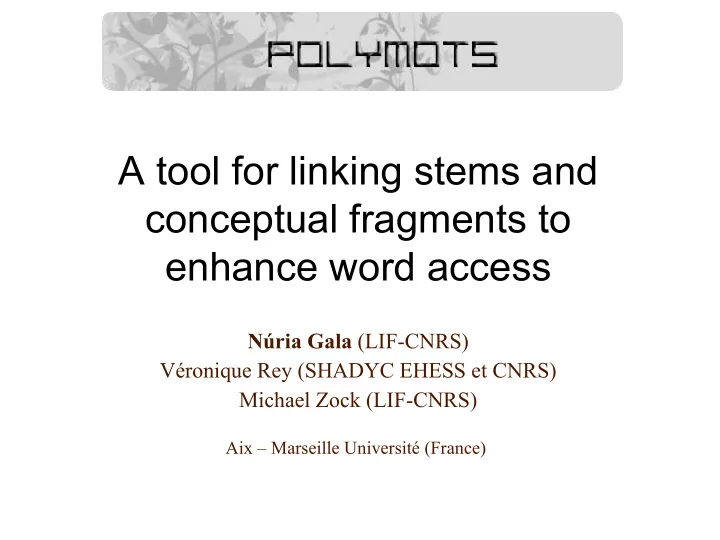

A tool for linking stems and conceptual fragments to enhance word access Núria Gala (LIF-CNRS) Véronique Rey (SHADYC EHESS et CNRS) Michael Zock (LIF-CNRS) Aix – Marseille Université (France)
Electronic dictionaries Mainly reader-oriented Heterogeneous information: • grammatical categories, • meaning (definitions), • examples of use (word's usages), • lexically related words, • lexical functions, • etymology • ... What is relevant for language production ?
Electronic dictionaries Some conclusions from E-lexicography conference (Louvain, oct. 2009): Still a lot to be done concerning: some hard points: word senses → usages the user needs : access to new words the exploitation of the electronic medium: queries, browsing, displaying information, etc.
Outline The speaker at the starting point Existing resources for French word families Morpho-phonological families Morphological description of lexical units Semantic features in a family Finding and producing words with Polymots Conclusion and further work
Starting point The speaker knows what s/he wants to say S/he knows the word... But s/he is unable to access it Tip of the tongue phenomena Paraphasia Language learning
Point of view of the language speaker Acces to words from conceptual fragments how do I say something 'sticky' and 'strong' in English? Access to words from formal relationships what's the word for a 'piece of clothe' or a 'band on the arm'? Writing a word with the appropriate orthograph do 'time' or 'weather' take a 'p' in French?
Aim of our work Capitalize on the bidirectionnal links between Semantics → conceptual fragments Morpho-phonology → stems Present a resource for French words grouped into morpho-phonological families Propose such a resource for vocabulary and orthography learning from a language producer's point of view to be used for education and by speech therapists
Existing resources Few resources to help the learner to acquire new vocabulary and/or to master spelling on the basis of 'families' Different concepts for 'word family' depending on the way lexical units are considered: (a) Etymological families (evolution) (b) Analogical families (synonymy) (c) Thematical families (domain)
Etymological families Diachrony : words evolution in time Words sharing a 'canonical form' or a 'lexical root' generally at the beginning of the creation of other words in the family Ex. Synapse http://www.synapse-fr.com /produits/Famille.htm
Analogical families Similarity, close meaning , same referent in the world Ex. Centre Collégial de Développement de Matériel Didactique du Québec http://www.ccdmd.qc.ca/fr/ jeux_pedagogiques /?id=1089&action=animer
Thematical families Term associations made by humans (broom → household, cleaning, house...) Lexical networks being used by machines Ex. JeuxdeMots (Lafourcade, 2007) http://www.lirmm.fr/jeuxdemots /generateGames.php
A resource for learning words on the basis of morpho-phonological families A family is a group of lexical units sharing: – Formal analogies : common stems • alternations are possible – Semantic continuum for users : similar conceptual ideas for the speaker • the degree of semantical cohesion in a family may vary
a phonological structure : – bras, brassard, bracelet, embrasser... /bRa/ – temps, temporel, température... /t@/ – preuve, prouver, approbation... /prØv/ ~ /pruv/ a semantic coherence for users: – vallée, avaler, avalanche... → going downhill – accident, suicide, acide… → death, danger – glu, agglutiner, gluant... → sticky, strong, together
The process of word construction implies morpho-phonological transformations: vocalic and consonantic alternations (Kiparsky, 1982) Keeping the phonological form of a lexical unit as a memory help: minimal listing or stem-only hypothesis (Taft, 1981)
Recognizing a link between two objects can lead to create a word on the basis of formal and semantic analogies keeping – the stem (ground: ' terre '; moon: ' lune ') – one or some ideas surface: ' terrasse ' moon-shaped, roundness: ' lunnettes '
Methodology (1) Manual global segmentation of a list of 20,000 words – stems identified afterwards, in synchrony Multiple occurrences – a stem being a lexical unit ( chaise, écran, falaise ) – or being shared by a list of units ( bouleau, boulette, boulier...; terre, enterrer, terrasse... )
Productivity 20,000 words, 2,004 stems = families The more general the stem's meaning, the larger the family Number of words Number of families 1 90 autel, chaise, mot, paupière ... 2 to 3 312 acier, alcool, fée, éternu, souris … 4 to 5 430 abeille, caprice, poisson … 6 to 7 322 alphabet, lot, nord, oeil … 8 to 9 185 ange, canon, drame, fisc, vache … 10 to 20 441 ample, fer, figure, monnaie … > 20 224 acte/ag, forme, mode, port ...
Methodology (2) Semi-automatic acquisition of conceptual fragments from available lexical and encyclopaedic ressources (Gala & Rey, 2009): – definitions from Wiktionnaire, – introductory paragraph in Wikipedia Grouping, filtering and weighting conceptual fragments Construction of semantic vectors
Examples thematic links synonyms common stems / common semantic units / hyperonyms Vache Embrasser [femelle 1] [mammifère 0.58] [serrer 1] [contenir 0.66] [saisir 0.66] [domestique 0.54] [ruminer 0.50] [bras 0.58] [attacher 0.44] [entourer [porteur 0.45] [espèce 0.43] 0.44] [étendre 0.32] [regard 0.32] [corner 0.41] [front 0.37] [adopter 0.29] [baiser 0.25] [englober [appartenir 0.32] [adulte 0.31] 0.16] [étreindre 0.15] [engager 0.13] [manoeuvrer 0.31] [peau 0.31] [récipient 0.31] ... Avaler [descendre 1] [abaisser 0.48] Alarme [accepter 0.38] [gosier 0.32] [manger 0.32] [couper 0.19] [signal 1] [ennemi 0.75] [arme 0.71] [mâcher 0.16] [supporter 0.09] ... [approcher 0.69] [prévenir 0.43] [dispositif 0.40] [surveillance 0.38]...
Conclusions A resource for lexical access on the basis of morphological and semantic grouping A tool for helping to learn vocabulary and spelling via word families A resource offering new functionnalities of navigation: words grouped into clusters
Future work Exporting data to a standard format (TEI) 1 Polymots online (fall 2010) Improve coverage Exploring portability to other languages (i.e. Romance languages) 1) Many thanks to L. Romary !
Thanks Thankful Thankfulness [appreciation, grateful, gratitude, expression, glad]
Recommend
More recommend